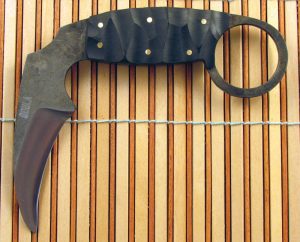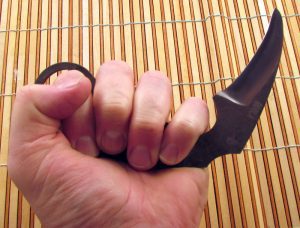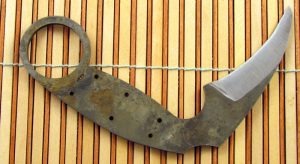 Gamers are fairly well versed on the wide variety of real life weapons that have made their way into our campaigns. It’s pretty unusual that I feel like I can show you something that there’s even a small chance you haven’t seen before. I’ll bet that for some of you, this is one of those rare gems.
Gamers are fairly well versed on the wide variety of real life weapons that have made their way into our campaigns. It’s pretty unusual that I feel like I can show you something that there’s even a small chance you haven’t seen before. I’ll bet that for some of you, this is one of those rare gems.
Blade-Rich Archipelagos
The region that includes the Malay and Indonesian archipelagos has a long and rich history of martial arts that include brutal and effective knife and sword fighting. These are combat-oriented arts, and most of them do not have sub-schools that have evolved into a sport form. To this day, they remain “all business.”
Standing behind that rich history is an equally fascinating culture of primitive bladesmithing. Although times change everywhere, and modern power tools have crept into almost all cultures, bladesmiths in this region still primarily use primitive methods.
A Cat’s Claw
 The kerambit is thought to have been created in the Sumatera Barat province of Indonesia, and it spread broadly from there. As with many weapons that started as tools (in this case, as in many, a farm implement), it was a peasant’s weapon. As its use as a weapon increased and its form evolved, it became more curved. There is some evidence that it’s based on the claws of a big cat. Looking at the knife, this makes perfect sense.
The kerambit is thought to have been created in the Sumatera Barat province of Indonesia, and it spread broadly from there. As with many weapons that started as tools (in this case, as in many, a farm implement), it was a peasant’s weapon. As its use as a weapon increased and its form evolved, it became more curved. There is some evidence that it’s based on the claws of a big cat. Looking at the knife, this makes perfect sense.
A Brutal Weapon
Starting as a peasant weapon used primarily by women, the kerambit came to be used in a number of fighting systems. The blade length and degree of curvature is variable, and it may have a finger ring, or not.
The finger ring increases retention and can be used to reinforce the fist for punching. The blade can be grasped with the pinkie through the ring, or with the index finger through the ring.
Hooking
Depending on how long the blade is and the angle of the curve, as well as the way the knife is held and oriented, it can be used to pierce, slash, or hook. It’s the hooking that makes this knife unique. When used in close combat, it can be hooked behind the neck, arm, or under the jaw. Aside from the primary damage caused by this attack, the successful hook can be used to pull an opponent into a second weapon, usually a large knife or short sword. Used by itself, it can enhance grapples and trips. It’s nasty and versatile.
How I Made It
 There were some specific elements requested to be built into this knife that required some careful design considerations. My customer wanted an overall 90% angle, a large ring, and a chisel grind. Because the ring was clearly going to get in the way of blade grinding, I made it in two pieces, with the ring being made from a piece of thick walled steel pipe and MIG welded to the handle after the blade was ground, hardened, tempered, and sharpened. Subsequent hand sharpening can be done fairly easily now, but I do the initial sharpening on a big belt grinder that requires room to maneuver.
There were some specific elements requested to be built into this knife that required some careful design considerations. My customer wanted an overall 90% angle, a large ring, and a chisel grind. Because the ring was clearly going to get in the way of blade grinding, I made it in two pieces, with the ring being made from a piece of thick walled steel pipe and MIG welded to the handle after the blade was ground, hardened, tempered, and sharpened. Subsequent hand sharpening can be done fairly easily now, but I do the initial sharpening on a big belt grinder that requires room to maneuver.
The handle is made from a phenolic product called Garolite (it’s the same thing as Micarta, but each name is trademarked), which is made from paper and epoxy that are squeezed together under high pressure. The scales are held in place with brass pins, and are textured by using a small wheel on the belt grinder.

Always a joy to see one of your articles Todd. I’ve known of the keramit, but never knew the history. Thanks for sharing and great work on the blade!
I know its not traditionally forged, but would you consider doing one on the terbutje at some point?
I’ve been wanting to do a macuahuitl for a long time, and they’re essentially the same thing, so, yeah. :)
I’m thinking I’d go with steel teeth for a twist.
Love the article and the work! Wow, that looks vicious, especially when picturing the hook-to-the-jaw maneuver you described! What does a scabbard for one of these look like, and how are they typically carried?
Chris, those are questions that I’d love to find answers to. So far, I’ve always been asked to make leather slip sheaths for these – simple blade covers for safe carry in gym bag, etc.
I’ll take an educated guess that they were traditionally carried in a wooden scabbards and tucked in the sash like belt often worn throughout Indonesia.
I just got a commission to make another one that will be carried, and I think what I’ll do is make a leather sheath that’s carried on the strong side and oriented so that the the index finger is inserted in the ring to draw the knife, and the handle is grasped as it’s drawn.
I hope that made sense.
The kerambit above that Mr. Gdula made for me is a piece of sere beauty. This one is a little more angled than others I have owned in the past – makes some of the hooking maneuvers more effective but I lose a little of the slip and give with cuts that would normally pass through the insulation (or muscles/tendons that they would simulate). I use it as a practice weapon on a frame-man made of 2×4’s that I wrap with pipe insulation and tape to simulate clothing/arms/etc. The knife is holding up well and the chisel edge is strong and able to put up with what I put it through… I don’t use it as a carry – cops are not understanding in California.
All in all, a great knife.
Thanks for stopping by, Wine Guy. It’s good to hear it’s seeing some hard use.